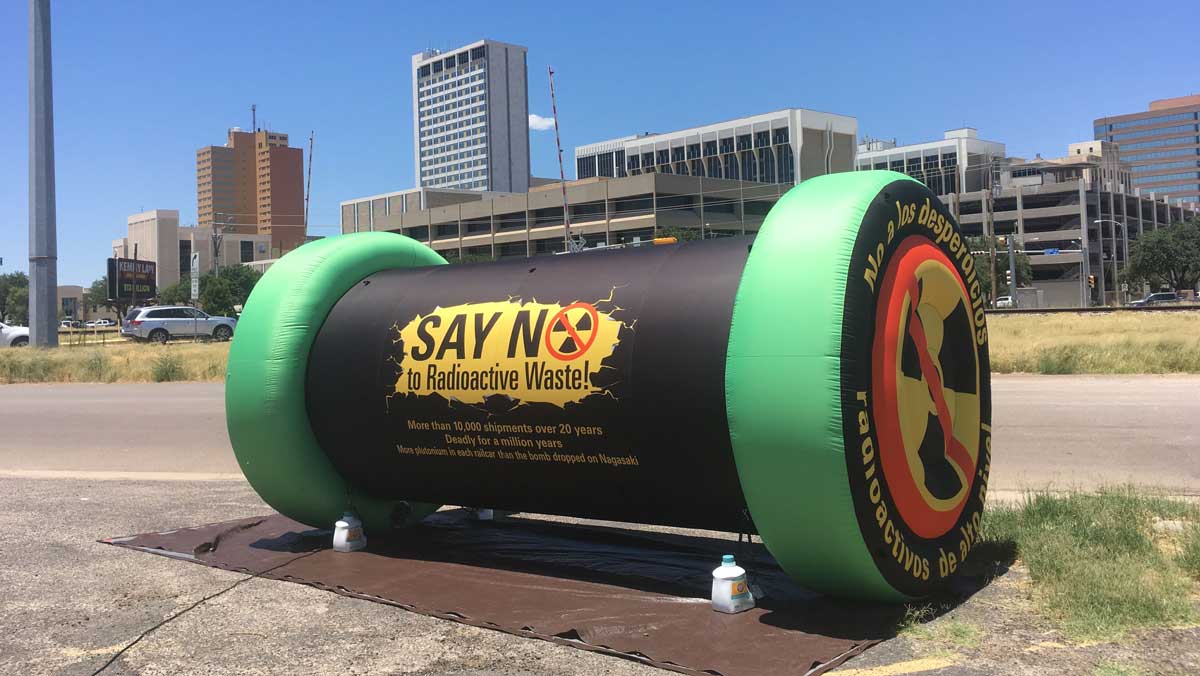ANDREWS, TX — Andrews County is grappling with the prospect of high-level nuclear waste being stored in their area. Thursday, July 15, the Andrews County Commissioners’ Court will hold a special meeting to decide on a resolution regarding the introduction of the waste into their community.
At issue is a facility located in the county on 14,000 acres that has been a storage site for low-level nuclear waste for over a decade. Currently, the only licensed storage facility sits on 1,338 acres of the very large property, according to Waste Control Specialists that operates the property. It is certified to dispose Class A, B and C low-level radioactive waste. This type of waste is disposed by fuel cycle and industrial facilities, hospitals, research centers, and from operations of the U.S. Department of Energy. Basically, the waste is comprised of tools, building materials and protective clothing exposed to radioactivity.
What is proposed to be stored at the Andrews property is high-level radioactive waste. This is the waste that not only comes from producing nuclear materials for defense purposes but also from nuclear power plants that create high-level nuclear waste in the form of spent fuel rods.
WCS partnered with another company, Orano USA, to bring spent fuel rods from nuclear power plants to Andrews County to be stored on a 332-acre tract on the WCS property until a permanent facility is found. The partnership is named Interim Storage Partners.
Andrews County Judge Charlie Falcon called for a meeting today of the commissioners’ court to hear citizen comments and decide if the court will pass a resolution in opposition or support of the storage of high-level nuclear waste there. Marfa Public Radio reported that in the past Falcon has been in favor of the nuke storage facility as it generates revenue for the county. The previous meeting of the court was packed with citizens speaking in opposition to the plan, according to the Midland Reporter-Telegram. The court could not make a motion then because the issue had not been posted on its agenda 72 hours prior to that meeting.
The last time it reported, WCS claimed it had filled Andrews County coffers with $1.47 million in fiscal year 2019. In all, by the end of FY 2019, the county had benefitted from over $13 million in quarterly payments since storage of low-level radioactive waste began there in 2010. The money is generated from a 5 percent surcharge on the company’s gross receipts. The county uses the money for grants to build community projects. According to WCS, the county built a $2 million Legacy Park that included demolishing the old county jail. A first responders memorial and veterans memorial along with a $2.3 million restoration project of youth baseball fields were also constructed with WCS surcharge funds.
The Sierra Club fought WCS on opening the low-level storage facility in Andrews more than a decade ago. It claimed the nuclear waste storage area was too close to valuable ground water tables—and alleged the TCEQ approved the original WCS storage facility after three TCEQ staff members resigned over the decision. In 2009, approval for spending $75 million generated from bonds issued by the county to subsidize building the low-level storage operation went to a vote in Andrews County and passed by only 3 votes, 642-639. Election irregularities were alleged but never investigated. More here.
State Rep. Brooks Landgraf introduced a bill to ban the storage of high-level radioactive waste in Andrews County, a part of his district, as well as he rest of the state. He introduced legislation this session, the 87th, but his bill was sent back to committee and never made it to the floor of the House.
If the Texas Legislature cannot stop the high-level nuke storage, there’s little hope a commissioners’ court in a sparsely populated rural Texas county can either.
Andrews County is not the only place at risk, claim opponents. Currently, spent fuel rods are stored on site at the nuclear power plant where the rods are created. Should high-level radioactive waste storage be approved at the facility near the Texas-New Mexico border, those radioactive spent fuel rods will be transported from plants across the country — the first customer is reported to be a nuke plant in South Carolina — along major transportation arteries and across Texas.

Subscribe to the LIVE! Daily
Required






Comments
NO
- Log in or register to post comments
PermalinkListed By: sanglo expat
Spent fuel rods constitute one of the most incredibly lethal forms of nuclear waste. While the half-lives of the daughter products contained in these things "only" may be a few centuries, as opposed to the half-lives of U-238, U-235, and Pu 239, 240, and 241, they are astonishingly bad things to store anywhere. Yeah, as long as we choose to generate electricity using fission reactors we need to think about what we do with this extraordinarily dangerous garbage. I don't care to have this damn stuff anywhere near me.
- Log in or register to post comments
PermalinkListed By: Stacy L
What this article fails to address is that the proposed bill did not place a “ban” on high-level nuclear waste. It only placed a ban on low level license holders taking high level nuclear waste. WCS even made it clear they would not withdraw their application for a high level license if the bill passed. The main objective of the bill was actually related to reducing fees on WCS (those mandatory fees that resulted in their contributions to the community) and decontainerization of low level waste. Lowering safety requirements and significantly reducing their contribution to the community seems pretty clear in their objectives. Perhaps Landgraf will read the bill WCS wrote for him more closely in the future.
- Log in or register to post comments
PermalinkPost a comment to this article here: